PEG-it Virus Precipitation Solution
Product Description
PEG-it is an easy way to get higher viral titers by concentrating virus
- Easy to use and cost-effective method for highly efficient viral concentration
- Concentrate all lentiviral particles 10- to 100-fold with PEG-it™
- Freeze pseudoviral particles without titer loss
- Non-toxic reagents safe for use with all target cell lines tested, including ES cells
- No special equipment required—avoid the expense of an ultracentrifuge
- No accumulation of cellular debris like with ultracentrifugation—avoid toxic and immunogenic reactions by using PEG-it™ instead
- Ideally suited for concentrating virus from large volumes—avoid the limited capacity per spin of ultracentrifugation
- Improve transduction of cells and prepare ultra-high titer preps for in vivo infections
- Sterile and ready for use in cell culture
- Couple precipitated virus with TransDux™ for high infectivity
- Completely compatible with System Bioscience’s LentiMag™ Magnetotransduction Kit
How it works
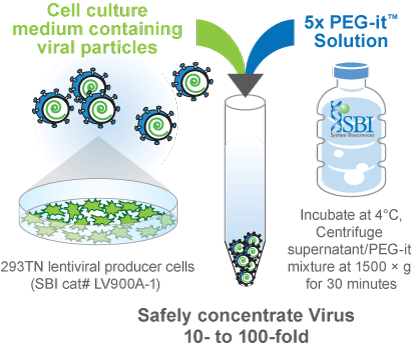
Supporting Data
Concentrate viral particles 100-fold
PEG-it™ Virus Precipitation Solution provides a simple and highly effective means to concentrate lentiviral particles, such as those produced with System Biosciences' pPACK Lentivector Packaging System. PEG-it™Virus Precipitation Solution is a formulation of polyethylene glycol optimized for the precipitation of all lentiviral-based particles. The solution is mixed with virus-containing cell culture supernatant, incubated at 4°C overnight, and centrifuged at 1500 × g to pellet precipitated viral particles. As a result, viral particle concentrations are increased 10- to 100-fold.
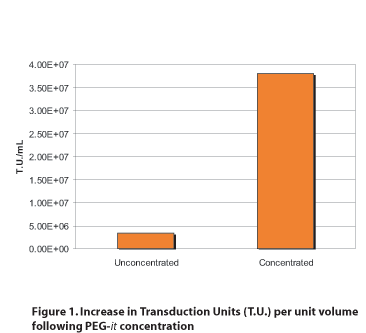
Non-toxic and Effective with Stem Cells
Sample Data of PEG-it concentrated lentivirus added to Human Stem Cells
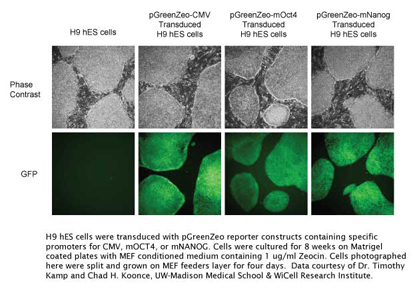
PEG-it™ protects virus from Multiple Freeze/Thaw Cycles
Not only does the PEG-it virus concentrate your lenti preparations, it also acts as a cryopreservative agent. Lentivirus concentrated with PEG-it lasts longer in the freezer and also survives quite well in aliquot freeze/thaw cycles. To test this, 50,000 HepG2 or HT1080 cells were seeded in 500 microliters of DMEM media containing 10% FBS in 24 well plate formats. The next day, the media was replaced with fresh media containing 1x TransDux virus transduction reagent (Catalog # LV850A-1, System Biosciences). Previously made frozen aliquots of packaged virus with a MSCV-GFP-T2A-RFP expression cassette (Catalog # LV605VA-1) were thawed on ice and 2 ul of virus was added to each well in triplicate. The aliquots were immediately frozen in dry ice and thawed again on regular ice and 2 ul of virus was again added to another three wells. This process was repeated three more times. Seventy two hours post transduction, cells were imaged for green fluorescence and documented. The images below show how well PEG-it protected the virus from multiple freeze/thaw cycles and produced high levels of GFP and RFP virus transgene expression.
Cell Images of LV605VA-1 Virus Transduction
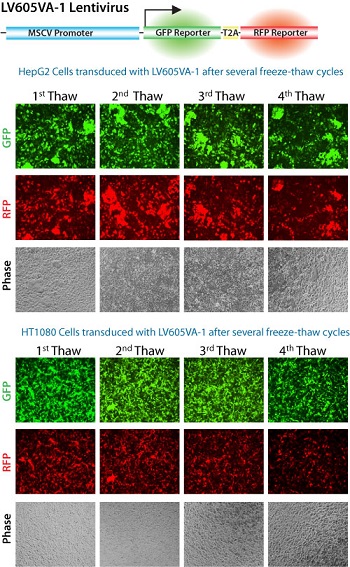
Infection Titering Data for LV605VA-1 Virus
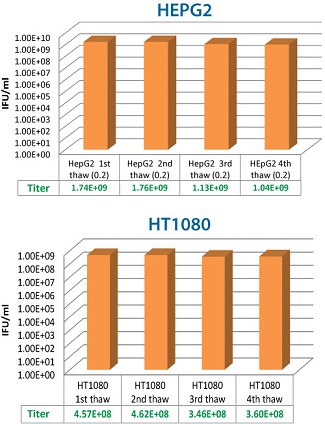
Product Citations
- An, M, et al. (2024) Engineered virus-like particles for transient delivery of prime editor ribonucleoprotein complexes in vivo. Nature biotechnology. 2024;. PM ID: 38191664
- Barisic, D, et al. (2024) ARID1A orchestrates SWI/SNF-mediated sequential binding of transcription factors with ARID1A loss driving pre-memory B cell fate and lymphomagenesis. Cancer cell. 2024;. PM ID: 38458187
- Baudrier, L, et al. (2024) One-pot DTECT enables rapid and efficient capture of genetic signatures for precision genome editing and clinical diagnostics. Cell reports methods. 2024;:100698. PM ID: 38301655
- Bracken, R, et al. (2024) Transcriptional Synergy in Human Aortic Endothelial Cells is Vulnerable to Combination p300/CBP and BET Bromodomain Inhibition. iScience. 2024;:110011. Link: iScience
- Cai, WF, et al. (2024) HAX1-Overexpression Augments Cardioprotective Efficacy of Stem Cell-Based Therapy Through Mediating Hippo-Yap Signaling. Stem cell reviews and reports. 2024;. PM ID: 38713406
You save 10 %
520,00 €
